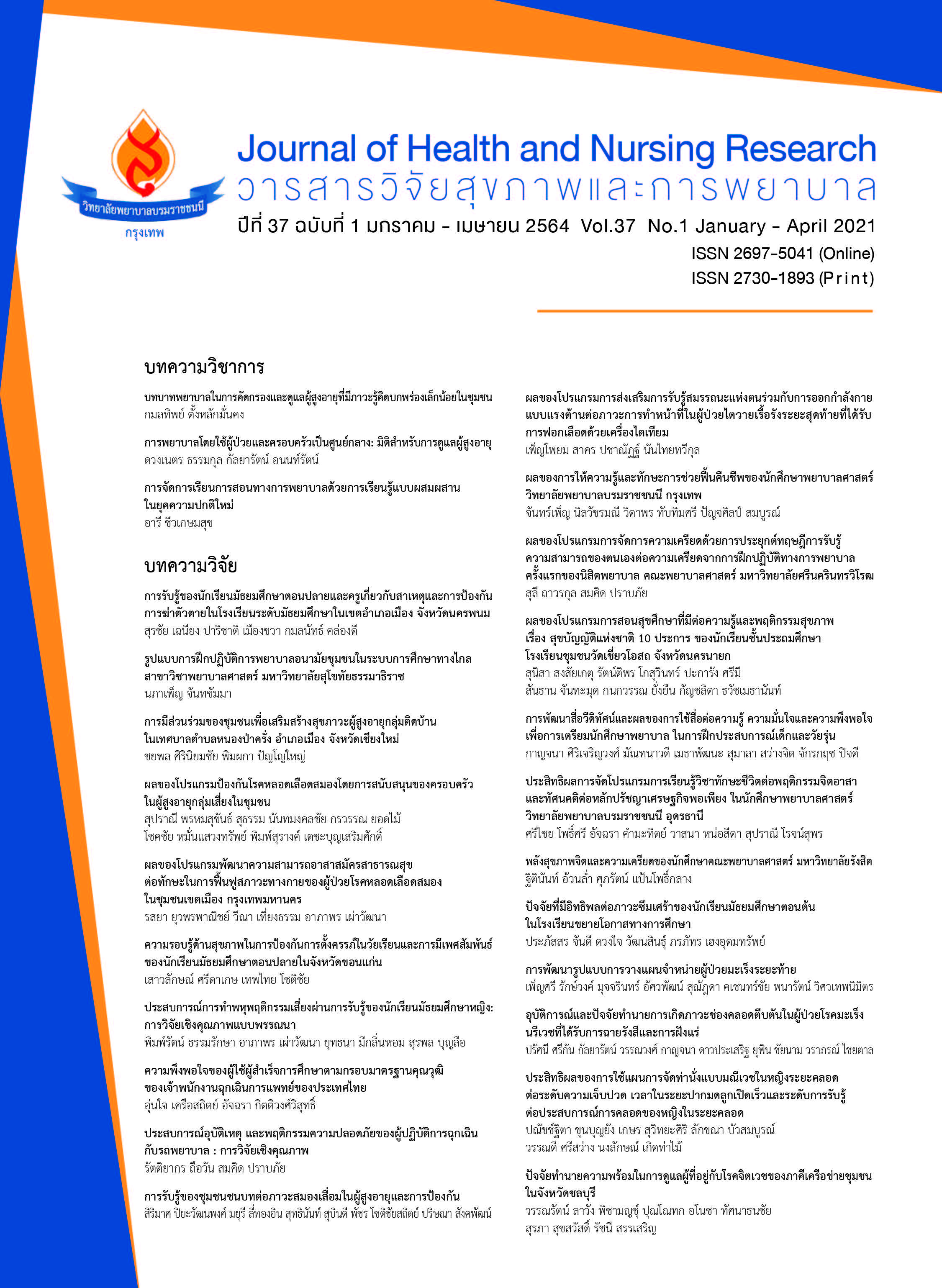ผลของโปรแกรมป้องกันโรคหลอดเลือดสมองโดยการสนับสนุนของครอบครัว ในผู้สูงอายุกลุ่มเสี่ยงในชุมชน
คำสำคัญ:
กลุ่มเสี่ยงโรคหลอดเลือดสมอง, การสนับสนุนของครอบครัว, การป้องกันโรคหลอดเลือดสมองบทคัดย่อ
บทนำ: โรคหลอดเลือดสมอง (cerebrovascular disease : CVD หรือ stroke) หรือที่เรียกกันว่าโรคอัมพฤกษ์ อัมพาต เป็นปัญหาสาธารณสุขที่สำคัญที่เป็นสาเหตุของการเสียชีวิตของคนทั่วโลก ทั้งนี้จากจำนวนผู้สูงอายุที่เพิ่มขึ้นทั่วโลก จึงคาดการณ์ว่าจำนวนผู้ป่วยและผู้เสียชีวิตจากโรคหลอดเลือดสมองมีแนวโน้มเพิ่มขึ้น วัตถุประสงค์การวิจัย: มีวัตถุประสงค์เพื่อศึกษาผลของโปรแกรมป้องกันโรคหลอดเลือดสมองโดยการสนับสนุนของครอบครัวในผู้สูงอายุกลุ่มเสี่ยง โดยประยุกต์ใช้แนวคิดแบบแผนความเชื่อด้านสุขภาพและทฤษฏีแรงสนับสนุนทางสังคม ระเบียบวิธีวิจัย: การวิจัยนี้เป็นวิจัยกึ่งทดลองแบบ 2 กลุ่ม วัดก่อนและหลัง กลุ่มตัวอย่างคือผู้ที่มีอายุ 65-80 ปี ป่วยด้วยโรคความดันโลหิตสูง โรคเบาหวาน โรคไขมันในเลือดสูงและโรคหัวใจ โรคใดโรคหนึ่ง แบ่งเป็นกลุ่มทดลองและกลุ่มเปรียบเทียบกลุ่มละ 30 คน ระยะเวลาการศึกษา 6 สัปดาห์ ประกอบด้วย 4 กิจกรรม ได้แก่ กิจกรรมโรคหลอดเลือดสมอง รู้ทัน ป้องกันได้ กิจกรรมล้อมรั้วบ้านต้านโรคหลอดเลือดสมอง กิจกรรมร่วมใจคนในบ้านต่อต้านโรคหลอดเลือดสมอง และกิจกรรมครอบครัวไร้โรคอัมพฤกษ์ อัมพาต เก็บข้อมูลด้วยแบบสัมภาษณ์ก่อนและหลังการทดลอง วิเคราะห์ข้อมูลโดยการใช้ร้อยละ ค่าเฉลี่ย ส่วนเบี่ยงเบนมาตรฐาน การทดสอบ Chi–Square test, Independent Sample t-test และ Paired Sample t-test ผลการวิจัย: พบว่าหลังการทดลองการรับรู้ความรุนแรง การรับรู้ประโยชน์ การรับรู้อุปสรรคและพฤติกรรมการป้องกันโรคหลอดเลือดสมองและการรับรู้การสนับสนุนของครอบครัวในการปฏิบัติตัว เพื่อป้องกันโรคหลอดเลือดสมองของผู้สูงอายุกลุ่มเสี่ยงในกลุ่มทดลองดีกว่ากลุ่มเปรียบเทียบอย่างมีนัยสำคัญทางสถิติ (p<.05) และสูงกว่าก่อนทดลองอย่างมีนัยสำคัญทางสถิติ (p<.05) สรุปผล: โปรแกรมการป้องกันโรคหลอดเลือดสมองโดยการมีสนับสนุนของครอบครัวสามารถทำให้ผู้สูงอายุกลุ่มเสี่ยงมีการรับรู้โอกาสเสี่ยง การรับรู้ความรุนแรง การรับรู้ประโยชน์และการรับรู้อุปสรรค ทำให้เกิดการเปลี่ยนแปลงพฤติกรรมในการดูแลสุขภาพในทางที่ดีขึ้น ข้อเสนอแนะ: หน่วยงานด้านสาธารณสุขสามารถนำโปรแกรมไปประยุกต์ใช้ในการส่งเสริมสุขภาพผู้สูงอายุให้มีสุขภาพดีได้
Downloads
เอกสารอ้างอิง
2. Lloyd-Jones D, Adams R, Carnethon M, De Simone G, Ferguson TB, Flegal K, et al. Heart disease and stroke statistics-2009 update: A report from the American Heart Association statistics committee and stroke statistics subcommittee. Circulation 2009;119(3):480-6.
3. Bureau of Policy and Strategy, Ministry of Public Health. Public Health Statistics A.D.2017. Bankok: Samcharoen Panich; 2017. (in Thai).
4. Bureau of Policy and Strategy, Ministry of Public Health. Public Health Statistic A.D 2016. Bankok: Samcharoen Panich; 2016. (in Thai).
5. Hanchaiphiboolkul S, Poungvarin N, Nidhinandana S, Suwanwela NC, et al. Prevalence of stroke and stroke risk factors in Thailand: Thai Epidemiologic Stroke(TES)Study. Journal of the Medical Association of Thailand 2011;94(4):427-36.
6. Phetchaburi Public Health Office. Incidence Rate of Stroke [Internet]. 2018. [cite 2018 March 20], Available from http://hdcservice.moph.go.th/hdc/main/Index_pk.php. (in Thai).
7. Phetchaburi Public Health Office. Genetic screening [Internet]. 2018. [cite 2018 March 20], Available from https://hdcservice.moph.go.th/hdc/reports/.
8. Boontae U, Duangchan C, Tawchantuk T, Polin S. Elder’s health status and quality of life under the health care provided by community network and simulated families. Journal of Nursing and Health Care 2017;35(3):175-85. (in Thai).
9. Nidhinandana S, Sithinamsuwan P, Chinvarun Y, Wongmek W, Supakasem S, Suwantamee J. Prevalence of post stroke depression in Thai stroke survivors studied in Phramongkutklao Hospital. Journal of the Medical Association of Thailand 2010;93 Suppl:60-4.
10. Prasat Neurological Institute, Ministry of public Health. Clinical Nursing Practice Guideline for Stroke. Bangkok: Thana Place; 2015. (in Thai).
11. Watcharanurak P. Klubklay A. Factors Influencing Preventive Behavior among Stoke-Risk Patients in Songkhla Province, The Southern College Network Journal of Nursing and Public Health 2017;4(1):217-33. (in Thai).
12. Callaghan P, Morrissey J. Social support and health: A review. Journal Advance Nursing 1993;18(2):203-10.
13. Becker MH. The Health Belief Model and preventive health behavior. Health Education Monographs 1974;2(4):354-85.
14. House, JS. The nature of social support. InMA. Reading (Ed). Work stress and social support Philadelphia: Addison Wesley; 1981.
15. Sompol C, Rawiworakul T, Kirdmongkol P. Effects of A Stroke Prevention Program for Older Adults with Hypertension. Journal of Public Health Nursing 2017;31(special edition):57-73. (in Thai).
16. Lemshow S, Hosmer DW, Kla J, Lwanga SK. Adequacy of sample size in health studies. England: John Wiley & Sons; 1990.
17. Ruchirawat S. Loengubol J, Wannaprapan B. Application of health belief model with social support for health behavior modi cation to stroke prevention in elderly patients with hypertension in Nongkatum Sub-District Health Promotion Hospital, Juntuk Sub-District, Pakchong District, NakhonRatchasima Province. The Office of Disease Prevention and Control 9th Nakhon Ratchasima Journal 2017;23(2):55-63. (in Thai).
18. Sanprakhon P, Chusri O, Wongwisadkul S. The Effects of health belief application program in older adults with risk of coronary artery disease in a community. Nursing Journal of the Ministry of Public Health 2018;28(3):87-100. (in Thai).
ดาวน์โหลด
เผยแพร่แล้ว
รูปแบบการอ้างอิง
ฉบับ
ประเภทบทความ
สัญญาอนุญาต
บทความที่ได้รับการตีพิมพ์ เป็นลิขสิทธิ์ของวารสารวิจัยสุขภาพและการพยาบาล (วิทยาลัยพยาบาลบรมราชชนนี กรุงเทพ) ไม่สามารถนำไปตีพิมพ์ซ้ำในวารสารฉบับอื่น


















